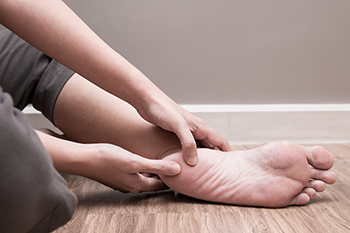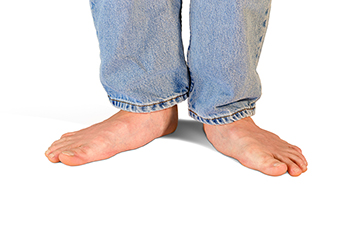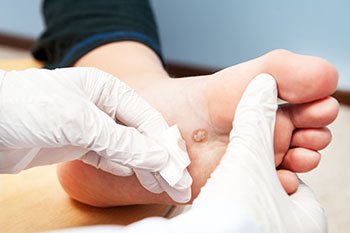Items filtered by date: August 2022
Heel Pain Can Come From Various Sources

There are many different reasons why people can feel heel pain. It can be a result of having Achilles tendonitis, a heel spur, or plantar fasciitis. These are the most common causes, and there are various ways the heel bone can be negatively affected. Heel pain can consist of a stabbing, burning pain, or it may be a chronic dull ache. It may be worse upon waking up in the morning, and walking can be difficult. Plantar fasciitis is the inflammation of the plantar fascia, the band of tissue that runs along the sole of the foot. Its function is to connect the heels to the toes, in addition to providing stability to the arch. People who enjoy running or who frequently participate in jumping activities may develop this condition, and it can cause severe pain and discomfort. A heel spur is defined as a bony growth that forms on the back of the heel bone, and it can come from extra bone tissue that can be caused by plantar fasciitis. The Achilles tendon is located in the calf, and it connects the heel to the calf muscles. This tendon can become torn or ruptured from an injury, and cause heel pain. If you are experiencing heel pain for any reason, it is strongly advised that you are under the care of a podiatrist who can determine what the cause is, and offer you correct treatment options.
Many people suffer from bouts of heel pain. For more information, contact Dan Kirk, DPM of Bluffton Foot & Ankle. Our doctor can provide the care you need to keep you pain-free and on your feet.
Causes of Heel Pain
Heel pain is often associated with plantar fasciitis. The plantar fascia is a band of tissues that extends along the bottom of the foot. A rip or tear in this ligament can cause inflammation of the tissue.
Achilles tendonitis is another cause of heel pain. Inflammation of the Achilles tendon will cause pain from fractures and muscle tearing. Lack of flexibility is also another symptom.
Heel spurs are another cause of pain. When the tissues of the plantar fascia undergo a great deal of stress, it can lead to ligament separation from the heel bone, causing heel spurs.
Why Might Heel Pain Occur?
- Wearing ill-fitting shoes
- Wearing non-supportive shoes
- Weight change
- Excessive running
Treatments
Heel pain should be treated as soon as possible for immediate results. Keeping your feet in a stress-free environment will help. If you suffer from Achilles tendonitis or plantar fasciitis, applying ice will reduce the swelling. Stretching before an exercise like running will help the muscles. Using all these tips will help make heel pain a condition of the past.
If you have any questions please contact our offices located in Bluffton and Celina, OH . We offer the newest diagnostic and treatment technologies for all your foot and ankle needs.
Little Known Facts About Clubfoot

Clubfoot is a congenital birth defect. The shape of the baby’s foot points down and is turned in. This happens because the tissues that connect the bone to the muscles in the leg are defective in some way. The tendons are shorter than they should be so the foot is pulled into an abnormal position. There may be additional changes to the ankle joint, bone of the foot, and muscles with clubfoot. Male babies are twice as likely to develop clubfoot at birth than females. A little less than half of those born with a clubfoot will suffer this condition in both feet. Having another birth defect, such as cerebral palsy or spina bifida, increases the chances of a baby being born with clubfoot. Infections during pregnancy, smoking, or using drugs can also increase the likelihood of this defect. This can be a genetic birth defect, especially if there is a family history on the father’s side of the family. Clubfoot has a higher incidence of occurrence in countries with lower incomes. Those born in Hawaii are six times more likely to be born with clubfoot, and those born in Japan are 50% less likely to be born with clubfoot. Clubfoot can be cured but this is not always the case. If your child is born with clubfoot, include a podiatrist on your healthcare team for proper diagnosis and treatment as soon as possible. Early intervention can make a difference.
Congenital foot problems require immediate attention to avoid future complications. If you have any concerns, contact Dan Kirk, DPM of Bluffton Foot & Ankle. Our doctor can provide the care you need to keep you pain-free and on your feet.
Congenital foot problems are deformities affecting the feet, toes, and/or ankles that children are born with. Some of these conditions have a genetic cause while others just happen. Some specific foot ailments that children may be born with include clubfeet, polydactyly/macrodactyly, and cleft foot. There are several other foot anomalies that can occur congenitally. What all of these conditions have in common is that a child may experience difficulty walking or performing everyday activities, as well as trouble finding footwear that fits their foot deformity. Some of these conditions are more serious than others. Consulting with a podiatrist as early as possible will help in properly diagnosing a child’s foot condition while getting the necessary treatment underway.
What are Causes of Congenital Foot Problem?
A congenital foot problem is one that happens to a child at birth. These conditions can be caused by a genetic predisposition, developmental or positional abnormalities during gestation, or with no known cause.
What are Symptoms of Congenital Foot Problems?
Symptoms vary by the congenital condition. Symptoms may consist of the following:
- Clubfoot, where tendons are shortened, bones are shaped differently, and the Achilles tendon is tight, causing the foot to point in and down. It is also possible for the soles of the feet to face each other.
- Polydactyly, which usually consists of a nubbin or small lump of tissue without a bone, a toe that is partially formed but has no joints, or an extra toe.
- Vertical talus, where the talus bone forms in the wrong position causing other bones in the foot to line up improperly, the front of the foot to point up, and the bottom of the foot to stiffen, with no arch, and to curve out.
- Tarsal coalition, when there is an abnormal connection of two or more bones in the foot leading to severe, rigid flatfoot.
- Cleft foot, where there are missing toes, a V-shaped cleft, and other anatomical differences.
- Macrodactyly, when the toes are abnormally large due to overgrowth of the underlying bone or soft tissue.
Treatment and Prevention
While there is nothing one can do to prevent congenital foot problems, raising awareness and receiving neonatal screenings are important. Early detection by taking your child to a podiatrist leads to the best outcome possible.
If you have any questions please feel free to contact our offices located in Bluffton and Celina, OH . We offer the newest diagnostic tools and technology to treat your foot and ankle needs.
Extra Weight May Equal Foot Pain

If you are obese, which is classified as having a body mass index (BMI) of 30 or higher, you may be putting undue stress on your feet and ankles. Studies show that obese individuals are more likely to have foot pain than those who are not obese. Some conditions that obesity may contribute to include flat feet, plantar fasciitis and other heel pain, hammertoes, and bunions. Also, being obese can increase your chances of having certain diseases that can negatively impact your feet such as gout and diabetes. Aside from trying to lose weight, you can relieve pain and reduce the negative effects of obesity on your feet by choosing better footwear and using custom orthotics in your shoes. Custom orthotics can help to relieve pressure points, support your arch, and distribute your body weight more evenly across your feet. A podiatrist can help you with these proactive measures as well as treat any painful conditions that excess weight may have caused in your feet.
The more you weigh, the harder your feet must work to support your body. If you’re an obese individual and are concerned about your feet, contact Dan Kirk, DPM from Bluffton Foot & Ankle. Our doctor can provide the care you need to keep you pain-free and on your feet.
Obesity and Your Feet
People who are overweight are putting more pressure on their ankles, knees, and hips as well as their feet. This unfortunately can lead to variety of different issues.
Problems & Complications Stemming from Obesity
- When the body is overweight, it tries to compensate by changing the way that it moves. An obese person may lean forward and put extra weight on the wrong part of the foot. This puts unnecessary stress on the feet.
- Obese people are also more likely to develop type II diabetes which is a condition that causes a lot of foot problems. People with diabetes often don’t feel the cuts and sores that they may have on their feet, which can lead to more complicated and severe issues.
- Plantar fasciitis is another foot condition that can be caused by obesity. Plantar fasciitis is an inflammation of the tissue along the bottom of the foot, which causes pain and stiffness while walking and climbing stairs.
If you have any questions, please feel free to contact our offices located in Bluffton and Celina, OH . We offer the newest diagnostic and treatment technologies for all your foot care needs.
Existing Medical Conditions May Cause Flat Feet

Having little or no arch in the foot can indicate flat feet. Flat feet can be observed while standing on the floor and checking to see if there is an arch present. People with this condition will see that their foot is lying flat against the floor with little or no space where the arch should be. Most babies are born with flat feet and the arch gradually develops at approximately age 10. Adults who have flat feet may have inherited them or have endured a foot injury. Additionally, there are existing medical conditions that can cause flat feet. These include arthritis, cerebral palsy, and spina bifida. People who are obese may notice they have acquired flat feet as a result of the weight the feet must bear. Some patients feel their weight is not distributed properly and the foot may roll inward. If you have flat feet, please consult with a podiatrist who may suggest wearing orthotics and can also show you how to perform specific exercises that can help with discomfort.
Flatfoot is a condition many people suffer from. If you have flat feet, contact Dan Kirk, DPM from Bluffton Foot & Ankle. Our doctor will treat your foot and ankle needs.
What Are Flat Feet?
Flatfoot is a condition in which the arch of the foot is depressed and the sole of the foot is almost completely in contact with the ground. About 20-30% of the population generally has flat feet because their arches never formed during growth.
Conditions & Problems:
Having flat feet makes it difficult to run or walk because of the stress placed on the ankles.
Alignment – The general alignment of your legs can be disrupted, because the ankles move inward which can cause major discomfort.
Knees – If you have complications with your knees, flat feet can be a contributor to arthritis in that area.
Symptoms
- Pain around the heel or arch area
- Trouble standing on the tip toe
- Swelling around the inside of the ankle
- Flat look to one or both feet
- Having your shoes feel uneven when worn
Treatment
If you are experiencing pain and stress on the foot you may weaken the posterior tibial tendon, which runs around the inside of the ankle.
If you have any questions please feel free to contact our offices located in Bluffton and Celina, OH . We offer the newest diagnostic and treatment technologies for all your foot and ankle needs.
Reminder: When Was the Last Time...?
The Difference Between Plantar Warts and Common Warts

There are several different kinds of warts that an individual may develop on their body. Plantar warts and common warts are among the most familiar. Usually, children and young adults are more susceptible to developing these kinds of warts. Both plantar and common warts occur when an individual is exposed to a certain strain of human papillomavirus, or HPV. This can happen when an individual touches someone else’s wart. What makes these two kinds of warts different is where they are typically located. Common warts can develop on any part of the body, although they are most typically found on the hands and knees. They are small, oval-like, rough patches of skin. On the other hand, plantar warts are found primarily on the bottoms of the feet, also known as the soles. Plantar warts will manipulate the natural lines that are located on the soles of the feet. If you have plantar warts, you might even see clogged blood vessels in the plantar wart that are of a black color. Plantar warts also differ from common warts because there are different potential treatments for each kind of wart. If you suspect that you have plantar warts, you should consider seeing a podiatrist who can help you treat warts.
Plantar warts can be very uncomfortable. If you need your feet checked, contact Dan Kirk, DPM from Bluffton Foot & Ankle. Our doctor will assist you with all of your foot and ankle needs.
About Plantar Warts
Plantar warts are the result of HPV, or human papillomavirus, getting into open wounds on the feet. They are mostly found on the heels or balls of the feet.
While plantar warts are generally harmless, those experiencing excessive pain or those suffering from diabetes or a compromised immune system require immediate medical care. Plantar warts are easily diagnosed, usually through scraping off a bit of rough skin or by getting a biopsy.
Symptoms
- Lesions on the bottom of your feet, usually rough and grainy
- Hard or thick callused spots
- Wart seeds, which are small clotted blood vessels that look like little black spots
- Pain, discomfort, or tenderness of your feet when walking or standing
Treatment
- Freezing
- Electric tool removal
- Laser Treatment
- Topical Creams (prescription only)
- Over-the-counter medications
To help prevent developing plantar warts, avoid walking barefoot over abrasive surfaces that can cause cuts or wounds for HPV to get into. Avoiding direct contact with other warts, as well as not picking or rubbing existing warts, can help prevent the further spread of plantar warts. However, if you think you have developed plantar warts, speak to your podiatrist. He or she can diagnose the warts on your feet and recommend the appropriate treatment options.
If you have any questions please feel free to contact our offices located in Bluffton and Celina, OH . We offer the newest diagnostic and treatment technologies for all your foot and ankle needs.

